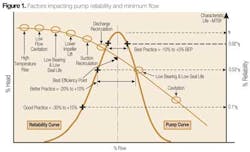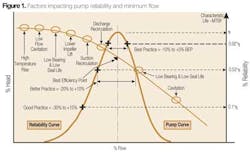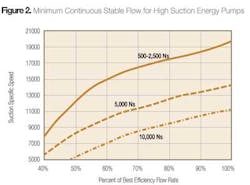By Allan R. Budris
There is no question that, from an efficiency and reliability standpoint, a centrifugal pump should be operated at or near its "best efficiency point" (BEP) flow rate (see WW, Dec. 2007). However, not all pump applications are static in nature and instead require the pump to operate over a range of flow rates. Further, it is important to know the "allowable operating range" (AOR) of a pump that will avoid major damage to the pump, including the minimum pump flow rate. All centrifugal pumps have limitations on the minimum and maximum flow rates at which they should be operated continuously (or for an extended period of time). Ideally, the pump manufacturer should supply this information.
Operating pumps at reduced capacities can cause various problems (see Figure 1), depending on the specific pump design, power, suction energy (WW, Oct. 2007), discharge energy (WW, Feb. 2013), and specific speed (WW, Sept. 2009). The minimum flow for a specific pump is dependent on the "damaging phenomena with the highest flow rate." The key potential low flow damaging factors that should be considered are as follows:
1. Temperature Rise: All pumps will experience an excessive temperature rise (and possible failure) at some reduced flow rate, if operated for an extended period of time. Therefore, lacking any other destructive minimum flow factor, "temperature rise" will define the pump minimum flow value. When a pump is run at a very low flow rate, the majority of the power input is converted to thermal energy, causing a rapid temperature rise. If the temperature rise continues, the liquid within the pump can vaporize and cause thermal expansion of the internal parts. This could result in seizure of the rotating parts, complete pump failure or destruction of the pump. To prevent flashing, sufficient flow must be maintained through the pump which will keep the liquid below the vaporization temperature. The value of this "minimum flow rate" is typically below about 10 percent of the best efficiency flow rate. The actual minimum flow rate due to temperature rise is a function of the input power, the pump efficiency at the minimum flow, the casing volume, and the allowable temperature rise. The Hydraulic Institute Standards offer formulas to more accurately calculate this minimum flow value.
2. Bearing Life: As discussed in the writer's Dec. 2007 column, bearing life decreases as the pump flow moves away from the pump BEP, which means that the pump should not be operated at a flow rate below that which will yield the minimum acceptable bearing life for the application. This limit is normally established by the pump manufacturer.
3. Shaft Fatigue Failure: As the pump flow rate is reduced below the pump BEP, the unbalanced, internal casing pressure force lowers the bearing life and increases the pump shaft stress. The writer remembers one pump whose minimum flow rate was based on exceeding the shaft fatigue strength. Again, the pump manufacturer should specify any such minimum flow limit.
4. High Specific Speed Pumps: Pump Head vs. Capacity and Power vs. Capacity curves become steeper, with higher values toward shut-off, as the pump specific speed increases. For specific speed values above about 4,500 to 5,000, the input horsepower starts to increase below the BEP flow rate and this increase becomes much greater for even higher values of specific speed. Because of this, pump users will often restrict the minimum flow rate for these pumps to reduce the pump pressure and/or required input power to avoid the requirement for large motors and/or stronger (thicker walled) piping. Also, some high specific speed pumps have a dip in the head-capacity curve (H-Q), which could cause the system H-Q curve to intersect the pump H-Q curve at more than one flow rate, making the system unstable (the pump would not know which flow rate to operate at). Here, the minimum flow rate should be above H-Q curve dip.
5. Suction Recirculation: This is a topic the writer has covered in many columns, along with the concept of Suction Energy, which can determine if pump operation should be avoided in the low-flow suction recirculation region. Suction recirculation, which occurs in all centrifugal pumps at some reduced flow rates, may or may not cause noise, vibration, erosion damage, and/or large forces on the impeller (which can affect shaft seal and bearing life). The likelihood of damage is heavily dependent on the pump suction energy (high or very high), as discussed in the writer's Oct. 2007 column as well as the NPSH margin, as discussed in the Jan. 2012 column. The start of suction recirculation (minimum stable flow rate) is dependent on the Suction Specific Speed, Specific Speed, and specific pump design. For high suction energy pumps, the start of suction recirculation generally ranges from 40 percent to 100 percent of the BEP flow, as shown in Figure 2. High (and especially "Very High") suction energy pumps should not be operated at flow rates below the start of suction recirculation, unless a NPSH margin ratio (NPSHA/NPSHR) of at least 3.0 can be provided. The writer's June 2010 Pump Tips Column gives tips on how to identify and avoid damage from Low Flow Pump Internal "Suction Recirculation." Ideally, the pump manufacture will specify the minimum flow rate to avoid operation in the suction recirculation region for High and Very High suction energy pumps.
6. Discharge Recirculation: Discharge recirculation is similar to suction recirculation and occurs at the impeller/casing discharge at some reduced flow rate below the pump BEP. Although not a common problem, it can do damage to some High (discharge) Energy pumps. According to the Hydraulic Institute, pumps with heads greater than 650 ft/stage that require more than 300 hp/stage have High (discharge) Energy. Ideally, the pump manufacture will specify the minimum flow rate that will avoid operation in the discharge recirculation region for High Discharge energy pumps where damage is predicted.
7. NPSH Margin Ratio: This is not typically an issue in determining the minimum continuous flow rate for a pump since in most cases the pump NPSHR decreases and the NPSHA increases as the flow decreases below the BEP capacity, at least above the start of suction recirculation. If the pump has "Low" suction energy and a NPSHR that increases at low flow rates, the minimum flow rate should be selected to insure that the NPSH Margin Ratio does not go below about 1.1 to 1.3. For "High" and "Very High" suction energy pumps, the minimum flow should insure a NPSH Margin Ratio of at least 3.0 if the pump must be in operated in the suction recirculation region (see WW, Jan. 2013).
Once a pump's minimum flow rate is established, one way to guarantee that the pump does not operate below this critical minimum value is by installing a bypass from the discharge line to some low pressure point in the system, upstream from the pump suction. The bypass should not lead directly back to (or close to) the pump suction to provide a sufficient heat sink that will avoid an excessive temperature increase. The bypass may be manually or automatically operated but must be open during periods of light load (pump flow) or when starting or stopping the pump. It should be noted that for high specific speed pumps, "bypass" flow control could be more efficient than using a throttle valve.
About the Author: Allan R. Budris, P.E., is an independent consulting engineer who specializes in training, failure analysis, troubleshooting, reliability, efficiency audits and litigation support on pumps and pumping systems. With offices in Washington, N.J., he can be contacted via e-mail at [email protected].
WaterWorld Articles Archives





